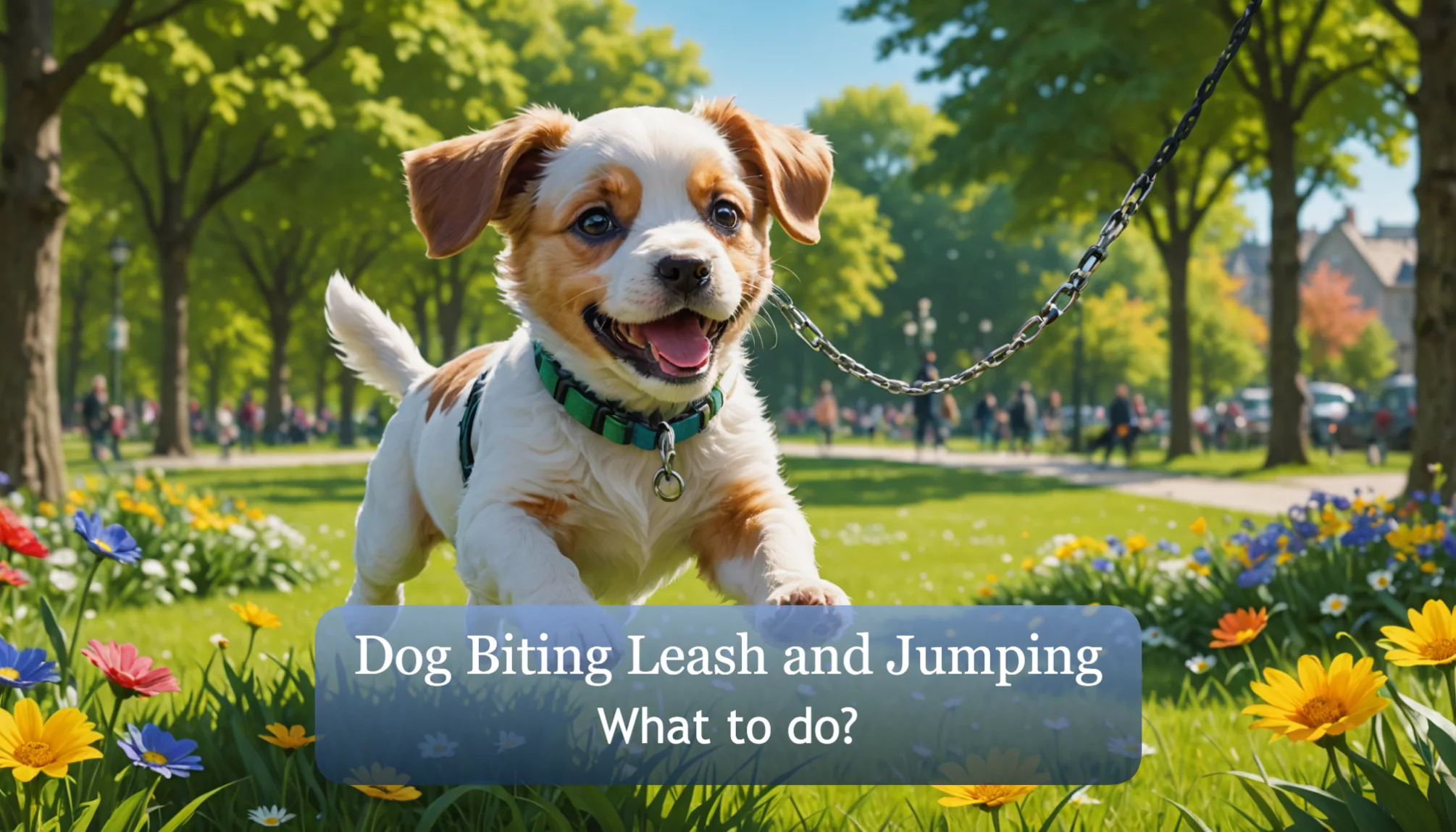Ever tried walking a puppy only to feel like you’re wrestling with a wild animal? If your adorable companion is constantly engaging in dog biting leash and jumping antics, you’re not alone! Many dog owners face this playful yet problematic behavior, and understanding why it happens is key to stopping it. Knowing how to tackle this issue not only makes walks more enjoyable but also keeps your pup safe and happy.
If left unchecked, leash biting can lead to even more bad behaviors and frustration during your adventures together. In this article, we’ll dive into the common reasons dogs bite their leashes, effective training techniques to put an end to this habit, and tips for managing your puppy’s energy levels. Get ready for a fun journey to a calmer, more obedient pup! Let’s leash up and get started!
Understanding Dog Behavior: Why Do They Bite the Leash?
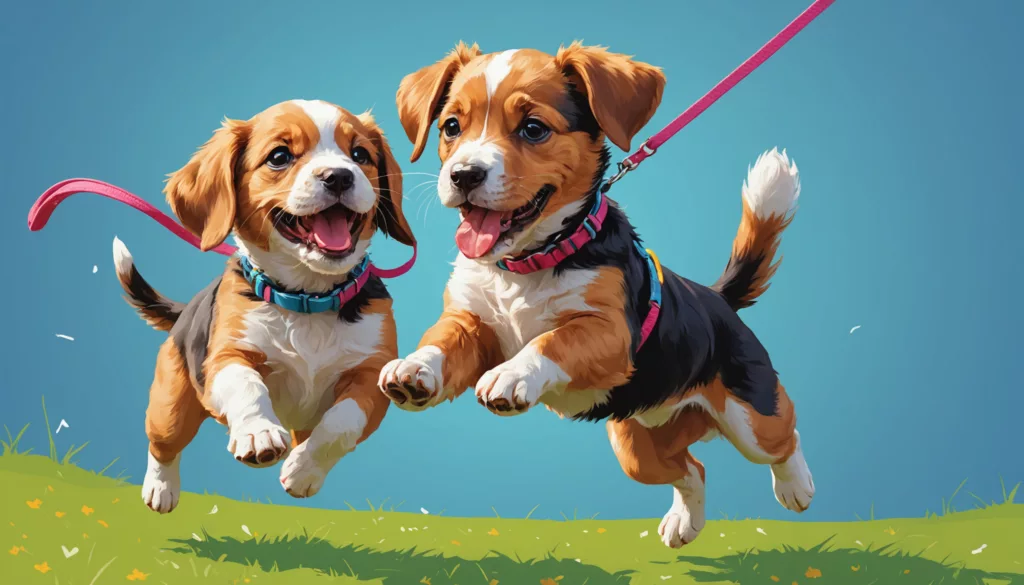
Dogs bite their leashes for several reasons. Knowing these reasons can help owners manage this behavior effectively.
Common Reasons Dogs Bite Their Leash
Many dogs bite their leashes out of excitement and playfulness. During walks, dogs often feel happy and full of energy. An excited dog may jump, pull, or tug on the leash. This behavior can show their enthusiasm. For instance, a dog might bite the leash when it sees another dog or a favorite toy.
Another reason for leash biting is anxiety and frustration. Dogs may feel stressed if they cannot explore their surroundings freely. If a dog is nervous in new places, it might respond by biting its leash. This behavior can be a way for the dog to cope. For example, a dog might bite the leash when facing loud noises or a crowded area.
Some dogs also engage in attention-seeking behavior. They learn that biting the leash draws attention from their owners, whether it is positive or negative. This reinforcement can lead to repeated behavior. When a dog realizes its actions result in interaction, it may continue to do so. Understanding these dynamics is crucial for dog owners, as they may inadvertently encourage undesired behaviors. In some cases, dog dominance behavior explained can shed light on why certain dogs exhibit attention-seeking actions; they may feel a need to assert themselves in the relationship with their owner. By recognizing these patterns, owners can take proactive steps to redirect their dog’s energy towards more appropriate activities, fostering a healthier bond between them.
The Role of Playfulness in Leash Biting
Playfulness is a natural part of dog behavior, especially in young dogs and puppies. Many dogs love chewing and playing with objects. If a dog sees the leash as a toy, it may start to bite and tug on it during walks.
For example, a puppy might treat the leash like a toy while walking. This behavior is typical as they learn what is acceptable. With proper training and maturity, this playful behavior usually decreases.
How Anxiety and Frustration Contribute to the Behavior
Anxiety can trigger leash biting significantly. Stressful places, such as busy streets or unfamiliar areas, can make dogs anxious. This anxiety may lead them to bite their leashes as a coping mechanism.
Frustration occurs when a dog wants to explore but feels restricted by the leash. For instance, a dog that spots birds may want to chase them but can only pull on the leash. This feeling of being held back can result in leash biting as a way to express their dissatisfaction.
Training Techniques to Stop Leash Biting
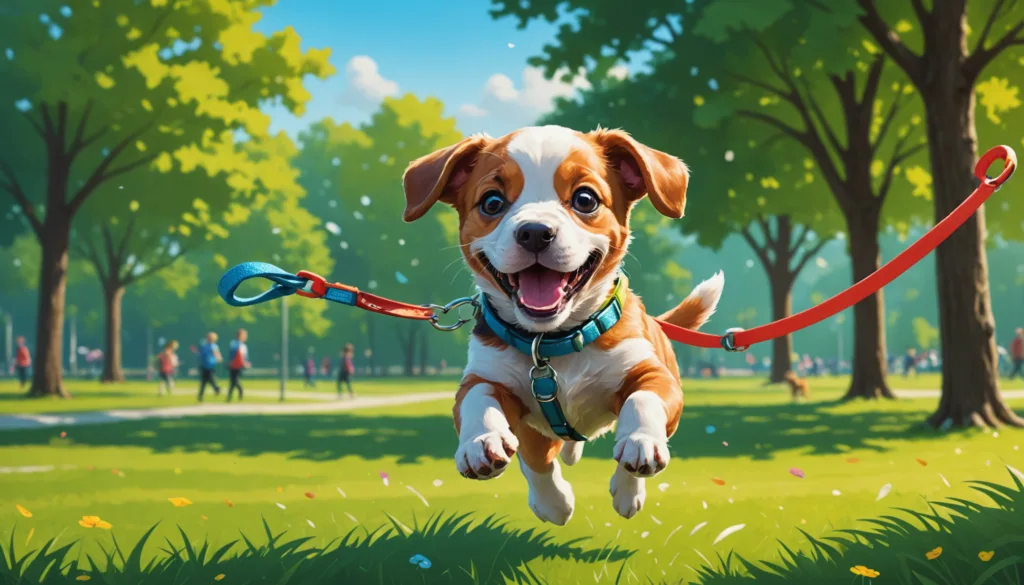
When dogs bite their leashes, it can frustrate owners, especially during walks. However, with the right training techniques, this behavior can be managed effectively. Here are proven methods to help stop leash biting.
Effective Training Methods to Prevent Leash Biting
- Positive Reinforcement: Rewarding a dog for good behavior is a key training method. When a dog walks calmly without biting the leash, they should receive a treat or praise. This helps the dog learn that calm behavior leads to rewards.
- Redirecting Attention: If a dog starts to bite the leash, divert their attention using a toy or another object. This encourages the dog to focus on something appropriate. For instance, throwing a ball or using a favorite tug toy can redirect their urge to chew.
- Calm Walking Techniques: When a dog bites the leash, stop walking immediately. Wait until the dog is calm before moving again. This approach teaches the dog that biting the leash stops the fun. By resuming the walk only when calm, the dog associates good behavior with continued activity.
How to Reward Your Dog for Good Behavior
Timing is essential when rewarding a dog. Here are tips for effective rewards:
- Immediate Praise: Provide a treat or praise right after the desired behavior occurs. For instance, if the dog walks beside the owner without biting, praise them at that exact moment.
- Use High-Value Treats: Regular treats may not always capture a dog’s attention. Using special treats, like pieces of chicken or cheese, can be more enticing and effective in reinforcing good behavior.
- Consistency is Key: Always reward the same behavior. For example, if a dog walks nicely without biting the leash, they should consistently receive a reward. This helps reinforce the learning process.
Incorporating Commands for Better Control
Teaching commands can greatly improve leash manners. Here are some useful commands:
- “Leave It”: This command signals the dog to stop focusing on the leash. Practice this command with treats or toys to help the dog understand its meaning.
- “Sit” or “Stay”: Incorporating these commands during walks can help manage excitement. For instance, when a dog starts to jump or bite, asking them to sit can calm them down.
- Consistency in Commands: Use the same command each time, and ensure all family members use the same words. This consistency helps the dog learn more efficiently.
Managing Your Dog’s Energy Levels
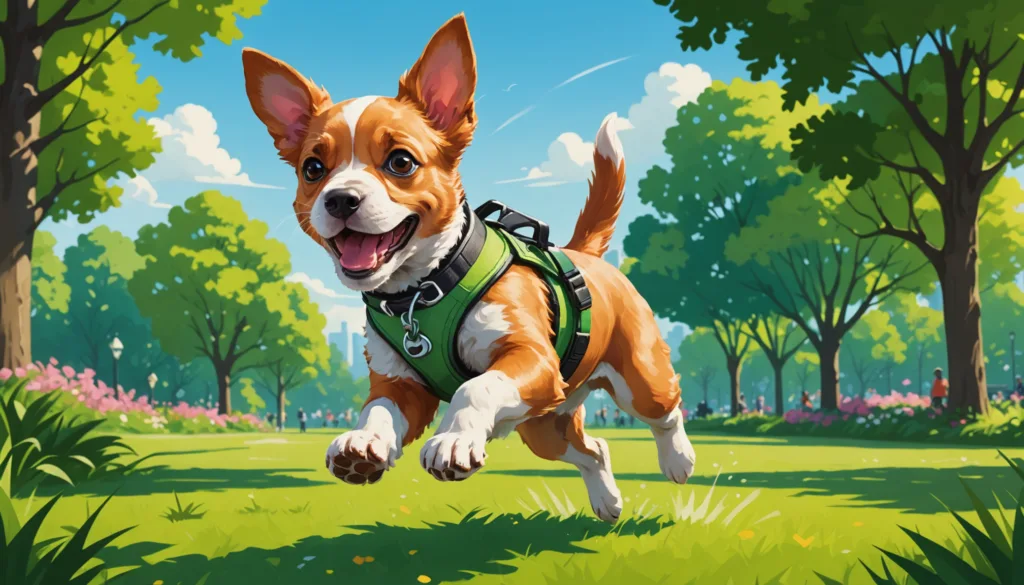
Understanding the Importance of Regular Exercise
Regular exercise is crucial for a dog’s health and happiness. Dogs, especially puppies, have high energy levels. Without enough exercise, they can become restless and develop unwanted behaviors, like leash biting and jumping. Exercise helps burn off this extra energy. A study on dog behavior reveals that increased physical activity is linked to better behavior in dogs.
Therefore, taking dogs on regular walks or engaging in play can prevent these issues. Keeping dogs active improves their mood, reduces anxiety, and strengthens the bond with their owners.
Activities to Help Tire Out a Playful Puppy
There are many enjoyable activities to tire out a playful puppy. Here are some effective options:
- Fetch: This classic game allows dogs to run and chase a ball or toy, providing both physical and mental stimulation.
- Tug-of-War: This game releases pent-up energy and strengthens the bond between the puppy and the owner.
- Structured Walks: Regular walks help dogs explore their surroundings and burn energy. Varying routes keeps the experience interesting.
- Obstacle Courses: Setting up a small obstacle course challenges a dog’s agility and keeps them engaged.
Engaging in these activities helps tire out a puppy and aids in training and socialization, which is vital for their development.
How Boredom Contributes to Leash Biting
Boredom significantly contributes to leash biting and other destructive behaviors. Dogs need both physical exercise and mental stimulation to stay happy. When bored, dogs may chew on leashes to entertain themselves. Activities that challenge a dog’s mind can prevent boredom.
Here are some ideas to keep a dog entertained:
- Interactive Toys: Toys that dispense treats keep dogs busy and mentally stimulated.
- Training Sessions: Teaching new tricks or commands engages dogs and reinforces good behavior.
- Socialization: Allowing puppies to interact with other dogs or people provides new experiences and reduces boredom.
References
Professional Help: When to Consult a Dog Trainer
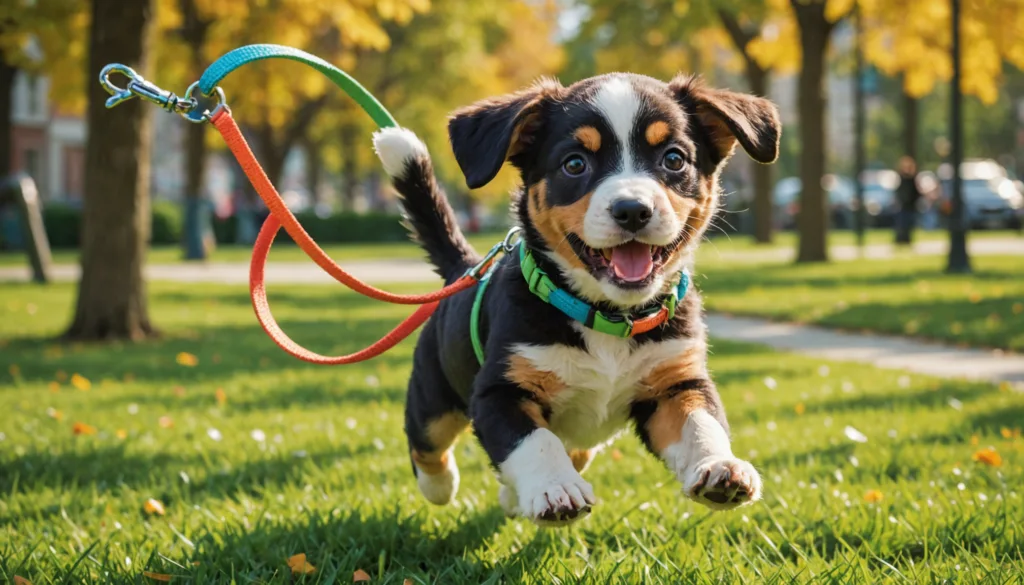
Signs You Need a Professional Dog Trainer
Consulting a professional dog trainer can be crucial when a dog’s leash biting and jumping behaviors are hard to manage. Here are key signs that indicate the need for professional assistance:
- Persistent Behaviors: If leash biting and jumping continue despite consistent training efforts, professional guidance may introduce new strategies.
- Aggression or Anxiety: If the dog shows signs of aggression, anxiety, or extreme frustration during walks, a trainer can help tackle these serious issues [Koinoniadogs].
- Training Difficulties: If basic commands are ignored or training sessions cause frustration, expert help may be necessary to guide both the dog and owner.
- Inconsistent Progress: If there are only occasional improvements in behavior while persistent bad behaviors remain, a trainer can pinpoint underlying causes and offer tailored solutions.
What to Expect from Training Sessions
Training sessions with a professional dog trainer typically follow a structured approach. Owners can anticipate the following:
- Behavior Assessment: The trainer begins with an assessment of the dog’s behavior to identify specific issues and the reasons behind leash biting or jumping.
- Customized Training Plan: Trainers create tailored training plans that address the dog’s unique needs, focusing on managing leash biting and jumping effectively [Wikipedia].
- Hands-On Involvement: Owners participate in training sessions, learning how to apply strategies and commands effectively.
- Practical Tools and Techniques: Trainers provide useful tools, tips, and techniques for walks to reduce undesirable behaviors and encourage positive actions.
- Follow-Up Sessions: Many trainers offer follow-up sessions to monitor progress and adjust the training plan as needed.
Developing a Long-Term Training Plan
Creating a long-term training plan is essential for maintaining consistency and ensuring lasting behavior changes. A solid plan generally includes:
- Consistent Commands: Establishing a set of commands that everyone in the household uses can help the dog learn better. Consistency reinforces good behaviors.
- Regular Practice: Scheduling consistent training sessions helps reinforce learned behaviors and keeps the dog’s skills sharp. This includes daily walks and playtime where good behavior is rewarded.
- Gradual Exposure: Slowly introducing the dog to different environments and stimuli helps them adapt, reducing anxiety or frustration that may lead to leash biting [Wikipedia].
- Progress Tracking: Keeping a record of the dog’s behavior during training assists owners and trainers in identifying improvements or areas needing more focus.
- Incorporating Fun: Making training enjoyable through games and rewards motivates the dog to learn faster. Activities like fetch or agility games can be integrated into the training plan to maintain engagement.
Expert Insights on Leash Behavior
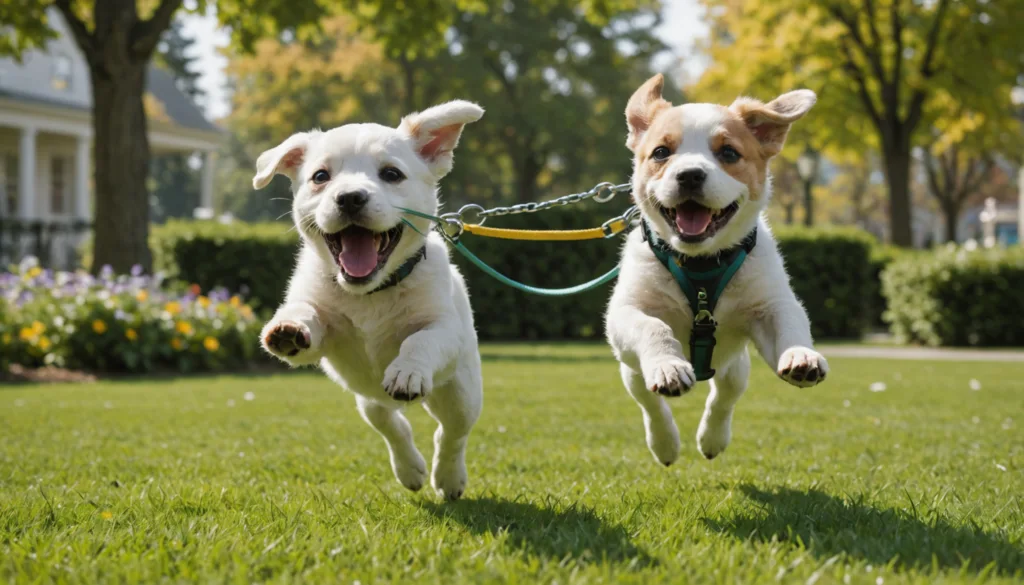
Research on Canine Behavior and Leash Biting
Understanding why dogs bite their leashes helps in training them effectively. Research shows that leash biting often comes from a dog’s natural instincts and feelings. Many dogs bite leashes due to excitement, anxiety, or playfulness.
For example, puppies are especially likely to engage in this behavior as they explore their surroundings. They see the leash as a fun object, similar to a toy. Additionally, dogs that feel anxious or frustrated may bite leashes as a way to cope, especially if they have not been socialized enough or exposed to new experiences.
Tips from Professional Trainers
Professional trainers provide essential advice for managing leash biting. Here are some key strategies drawn from their expertise:
- Redirect Attention:
When a dog starts biting the leash, redirect its focus to a toy. This helps break the habit and teaches the dog what is acceptable to chew. - Use Positive Reinforcement:
Give praise and treats when the dog walks calmly without biting the leash. This reinforces good behavior and encourages the dog to repeat it. A handful of treats can grab the dog’s attention during walks. - Implement Commands:
Teach commands like “leave it” or “heel” to gain better control over the dog’s actions. This can help manage excitement and reduce leash biting. Consistent training helps the dog learn these commands. - Ensure Regular Exercise:
Regular physical activity is crucial for managing a dog’s energy. A well-exercised dog is less likely to show undesirable behaviors like leash biting. Activities such as fetch or structured walks help burn off extra energy. - Monitor for Anxiety Signs:
Be aware of signs of anxiety, such as pacing or whining. If these behaviors occur during walks, consider consulting a professional trainer for tailored strategies to reduce anxiety.
Conclusion
Now you know that leash biting can come from a puppy’s playful nature, anxiety, or even boredom. It’s important to understand these reasons to help your furry friend learn how to behave better. By using effective training techniques, rewarding good behavior, and ensuring your puppy gets plenty of exercise, you can make walks a more enjoyable experience for both of you!
If you’re still having trouble, don’t hesitate to seek help from a professional dog trainer. With consistent training and patience, your puppy can learn to stop biting the leash and enjoy their walks. Remember, every step you take is a step toward a happier and calmer pup! Keep exploring ways to make your dog’s behavior even better!
FAQs
1. What should be done if a dog continues to bite the leash?
To address leash biting, employ distraction techniques with engaging toys, reward calm walking with treats and praise, and teach commands like “leave it” and “no bite.” Start with shorter walks and gradually increase the duration. If the issue persists, consult a professional dog trainer for personalized guidance.
2. Are there specific breeds more prone to leash biting?
Yes, certain breeds are more prone to leash biting due to their energy levels and playful nature. Breeds like Labradors, Terriers, and Border Collies often show higher energy, making them more likely to engage in playful behaviors such as leash biting. Their natural instincts to chase and play contribute to these behaviors during walks. However, any dog, regardless of breed, can develop this habit if not trained properly.
3. How can anxiety be identified when a dog bites the leash?
Leash biting stemming from anxiety can be identified by observing specific behaviors. Excessive barking, pacing, and attempts to escape while on the leash are strong indicators. Pay close attention to the dog’s body language, such as stiff posture, lowered ears, and a tucked tail. Consider the context; leash biting in unfamiliar environments or during social interactions may signal anxiety. Recognizing these signs is crucial for implementing effective training and management strategies to address the underlying anxiety.

